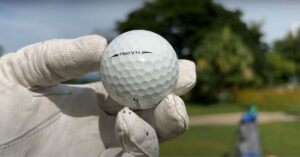Golf Ball That Makes Noise: Hear the Game Like Never Before
Golf is a sport known for its elegance and tranquility, but what if we told you there’s a golf ball that can add a whole new dimension to your game? Imagine hearing the game like never before, amplifying every swing, every putt, and every moment on the course.
A golf ball that makes noise is designed to enhance your golfing experience by adding a new auditory dimension to the game. With these balls, you hear every swing, putt, and impact like never before, giving you a unique and immersive perspective.
This article explores the innovative technology behind this unique golf ball and how it enhances your golfing experience.

Science Behind Noise-Producing Golf Balls
Noise-producing golf balls are designed to make a loud noise when they are hit.
This noise is created by a small speaker or piezoelectric element in the ball that is activated when the ball is hit. The noise is typically a high-pitched squeal or chirp.
The science behind noise-producing golf balls is based on the principle of piezoelectricity.
Piezoelectricity is the ability of certain materials to generate an electric charge when they are subjected to mechanical stress.
In the case of noise-producing golf balls, the speaker or piezoelectric element is made of a piezoelectric material.
When the ball is hit, the impact creates mechanical stress in the material, which generates an electric charge.
This electric charge then powers the speaker or piezoelectric element, which produces the loud noise.
Noise-producing golf balls are not currently allowed in tournament play. However, they are becoming increasingly popular for recreational use.
Some people believe that the noise helps them to track the flight of the ball, while others simply enjoy the novelty of the noise.
There are a few potential drawbacks to noise-producing golf balls. One concern is that the noise could be disruptive to other golfers on the course.
Another concern is that the noise could scare wildlife. However, the noise from noise-producing golf balls is typically not as loud as other noises on a golf course, such as the sound of a golf cart or people talking.
Overall, noise-producing golf balls are a relatively new technology that is still being developed.
These balls have some potential drawbacks, but they are also becoming increasingly popular for recreational use.
List Of Golf Balls That Makes Noise

Golf balls that make noise add an extra element of excitement and fun to your golfing experience.
These innovative balls are designed to produce distinct sounds upon impact, enhancing your game and providing auditory feedback.
Here is a list of golf balls that make noise:
SHOCK’D Golf Balls
These balls are designed to make a loud noise when they are hit. The noise is created by a small speaker in the ball that is activated when the ball is hit. The noise is typically a high-pitched squeal or chirp.
Mach One Golf Balls
These balls also make a loud noise when they are hit. The noise is created by a small piezoelectric element in the ball that is activated when the ball is hit. The noise is typically a high-pitched squeal or chirp.
Essential Values Exploding Golf Balls:
These balls are not technically noise-producing golf balls, but they do make a loud noise when they hit the ground.
The balls are filled with a small amount of gunpowder, and when they hit the ground, the gunpowder explodes, creating a loud noise.
Essential Values Exploding Golf BallsOpens in a new window
Shanker Golf Balls
These balls are not noise-producing golf balls, but they do have a funny saying printed on them.
The saying is typically something like “I shanked it” or “I’m a terrible golfer.” When the ball is hit, the saying is revealed.
Pros and Cons Of Using Golf Balls That Make Noise
Golf balls that make noise have gained popularity in recent years, offering a unique twist to the game.
However, like any innovation, there are pros and cons to consider when using these audible golf balls.
Let’s explore the advantages and disadvantages of using golf balls that make noise.
Pros
- Helps track the flight of the ball: The noise can help you to track the flight of the ball, especially if you are a beginner golfer. This can help you to improve your accuracy and distance.
- More enjoyable: Some people simply enjoy the novelty of these balls’ noise. It can make golf more fun and exciting.
- Less disruptive than other noises on the course: The noise from noise-producing golf balls is typically not as loud as other noises on a golf course, such as the sound of a golf cart or the sound of people talking.
Cons
- Could be disruptive to other golfers: The noise could be disruptive to other golfers on the course, especially if you are playing in a crowded area.
- Could scare wildlife: The noise could scare wildlife, such as birds or deer.
- Not allowed in tournament play: Noise-producing golf balls are not currently allowed.
Tips For Incorporating Noise-Making Golf Balls Into Your Practice
The sound they produce upon impact can provide valuable feedback on your swing and help you make adjustments.
Here are some tips to make the most of incorporating noise-making golf balls into your practice:
Choose the Right Environment
- Select a practice area with enough space and minimal distractions to avoid disturbing other golfers.
- Consider using noise-making golf balls at a driving range or in an open field where you have ample room to swing freely.
Start with Short Irons
- Begin by practicing with noise-making golf balls using shorter irons like a pitching wedge or a 9-iron.
- These clubs require less power, allowing you to focus more on the impact and sound rather than distance.
Listen for Impact Quality
- Pay attention to the sound the noise-making golf ball makes upon impact with the clubface.
- A solid and crisp sound indicates a clean strike, while a dull or off-center sound suggests a mishit.
Analyze Ball Flight
- Observe the trajectory and flight of the noise-making golf ball after impact.
- The ball’s flight can reveal important information about your swing, such as whether you are hitting it too high, too low, or with a slice or hook.
Work on Timing and Tempo
- The noise-making golf balls can help you refine your timing and tempo.
- Focus on creating a smooth and rhythmic swing, listening for consistent sounds to indicate proper synchronization.
Use in Combination with Visual Feedback
- Combine the use of noise-making golf balls with visual feedback tools like video recording or swing analysis apps.
- This way, you can correlate the sound of impact with the visual cues of your swing to identify areas for improvement.
Gradually Transition to Regular Golf Balls
- As you become more comfortable and confident with noise-making golf balls, gradually transition back to using regular golf balls.
- Apply the lessons learned from the sound feedback to improve your swing mechanics and ball-striking accuracy.
Practice Regularly
- Consistency is key in golf, so incorporate noise-making golf balls into your practice routine regularly.
- Set aside dedicated practice sessions to focus on using these balls to refine your swing and overall game.
Maintenance And Care For Golf Balls That Make Noise
Golf balls that make noise during play require proper maintenance and care to ensure optimal performance and longevity. By following these guidelines, you can keep your noisy golf balls in top condition.
Cleaning
- Regularly clean your noisy golf balls using warm water and mild soap.
- Gently scrub the surface with a soft cloth or sponge to remove dirt and debris.
- Avoid using harsh chemicals or abrasive materials that could damage the ball’s outer layer.
- Rinse thoroughly and dry the balls with a clean towel before storing them.
Storage
- Store your noisy golf balls in a cool and dry place to prevent moisture buildup.
- Keep them away from extreme temperatures and direct sunlight, as these can affect the ball’s performance.
- Consider using a golf ball storage bag or container to protect them from potential damage.
Inspection
- Before each round of golf, inspect your noisy golf balls for any visible signs of damage.
- Look for cracks, dents, or other abnormalities that could impact the ball’s flight and sound.
- If you notice any significant damage, it’s best to replace the ball with a new one.
Replacement
- Over time, golf balls can lose their effectiveness and become less noisy.
- If your noisy golf balls no longer produce the desired sound, it may be time to replace them.
- Consider trying different brands or models to find ones that suit your preferences.
Frequently Asked Questions
To help you understand more about this unique golf ball, we have compiled a list of frequently asked questions:
What Is the Golf Ball That Makes Noise?
The Golf Ball That Makes Noise produces a distinct sound upon impact, adding excitement and entertainment to your game. It uses a small internal mechanism that activates when it contacts the clubface.
How Does the Golf Ball That Makes Noise?
The golf ball contains a small mechanism that produces an audible sound when struck by a club. This adds a unique and enjoyable atmosphere to the golf course without affecting the ball’s performance or flight trajectory.
Is the Golf Ball That Makes Noise Legal for Tournament Play?
The Golf Ball That Makes Noise complies with golf’s governing bodies’ rules and regulations. It is thoroughly tested and approved for tournament play, ensuring its legality during competitive events. Enjoy the benefits of this exciting golf ball without any concerns about its compliance.
Can I Control the Volume of the Noise Produced by the Ball?
No, the volume of the sound produced by the Golf Ball That Makes Noise is preset and cannot be adjusted. The purpose of the noise is to add an element of surprise and enjoyment to your game, creating a unique experience with every shot.
Where Can I Purchase the Golf Ball That Makes Noise?
The Golf Ball That Makes Noise can be purchased at select golf retailers and online stores. Check with your local golf shop or visit authorized websites to find and buy this innovative product. Elevate your golf game and blast with the Golf Ball That Makes Noise!
Conclusion
The innovative golf ball that makes noise brings the game a new level of excitement. Its unique design adds a thrilling auditory element, enhancing player engagement and enjoyment.
With this groundbreaking addition, golf enthusiasts can now experience a truly immersive and interactive golfing experience like never before.


![How to Clean Golf Balls? [Proven Methods for a Spotless Shine] How-to-Clean-Golf-Balls](https://giftedgolfers.com/wp-content/uploads/2023/09/How-to-Clean-Golf-Balls-300x157.jpg)


